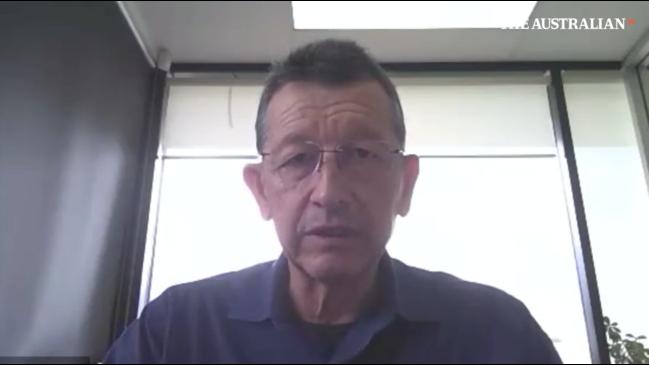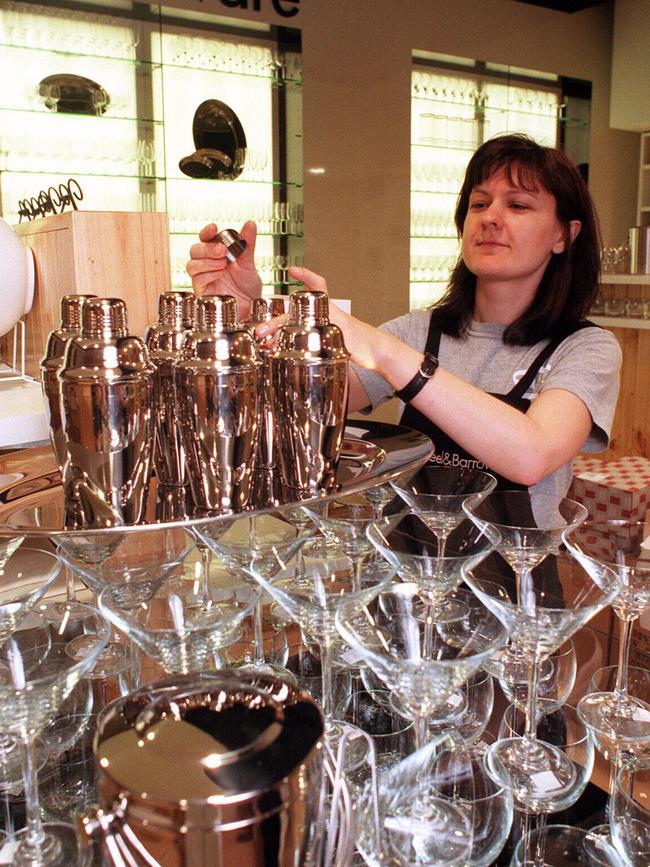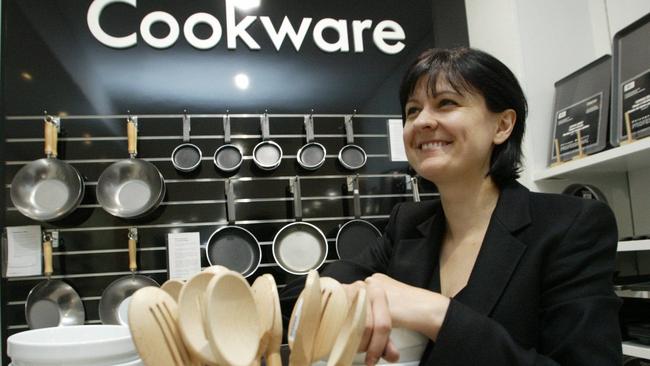Bickford’s drinks owners Angelo and Mary Kotses built an empire from the ground up
They built a huge homewares chain, saved an iconic Aussie drinks brand then, amid a cancer diagnosis, bought an historic mansion to renovate. Is there no stopping Angelo and Mary Kotses?

Bickford’s is an iconic Australian drinks brand. Its brown lime and bitter-lemon cordials have been produced from its South Australian home since 1874.
But in late 1992, the firm had been out of Bickford family control for more than a decade and was owned by Adelaide entrepreneur Guy Lloyd, who pioneered the helicopter industry in South Australia. It was also bleeding cash.
“An old boss of mine rang me and said, ‘Look, I’ve got a guy who bought a business called Bickford’s and he’s having a bit of a problem with it. Do you mind looking at it,” recalls the brand’s now-owner, Adelaide businessman Angelo Kotses.
“I went out to supermarkets, which is what I still do every day, and had a look. While the business was losing money, Schweppes simply couldn’t delete Bickford’s off the shelves. It was still in the bottom left and top right hand corners. When I went back to Guy, he said to me, ‘I’ve never lost anything in my life. I’m not going to start losing now. What will it take for you to come in and fix it?’,”
That night Kotses raised the prospect of running Bickford’s with his wife Mary, an accountant by training. She looked at the balance sheet and shrieked: “This company has negative equity!”
“Typical of me I said to her, ‘Well, there’s only one way and that is up,” he recalls.
“So I thought ‘Well, we’ve got to give it a go’.”
The Kotses mortgaged their house to take equity in the business, took full management control and agreed on a timeline to buy out the Lloyd family, a transaction that completed seven years later.

In the interim, Kotses expanded Bickford’s beyond cordials and the result was a fizzy beverage named Spritz, launched in October 1993, the same month Guy Lloyd tragically passed away with brain cancer. He was only 48.
“Guy was just an absolute gentleman, but his family also backed me to get things started and then allowed me to manage the business,” Kotses says.
To this day he calls Spritz Australia’s first premium soft drink and it put Bickford’s on the path to becoming a world-class beverage manufacturer.
The firm, which celebrates its 150th anniversary this year, now produces more than 400 products across 35 trademarks, exports its iconic Australian flavours to over 45 countries and employs more than 250 people – some of whom are 30-year veterans.
Yet it still remains a privately owned business that crafts its entire range of beverages including juice, iced coffee syrup, traditional soft drinks and alternative dairy products on-site at its Salisbury South facility in Adelaide suburbia.
The factory produces 12,500 bottles of lime juice cordial an hour and it remains one of Bickford’s best-selling products.
As part of the 150th anniversary celebrations, six new flavours were launched earlier this year as well as a Collector’s Edition Lime Cordial label incorporating nostalgic elements from the past.
“The only way we are going to stay alive in manufacturing in Australia is to create some advantage that our competitors can’t match us on. I will keep investing in this business,” Kotses declares.
“I take a salary but I’ve never pulled a dividend out of the business. Because it all goes into funding growth. Everything goes back into investing in the future.”
Real life skills
Angelo Kotses was born in 1960 in the village of Aetos in Florina in the Macedonia region of Greece. His was one of four families living under the one roof.
It was his aunt that inspired his parents’ move to Australia. After she relocated Down Under, she sent a note back to the family in Greece which simply read: “This is a great place to camp.”
Kotses and his family migrated in 1964, first to the then crime-torn inner city Sydney suburb of Redfern where his father became a welder and his mother worked at ACI glass.
The family then moved to Adelaide in 1976, where Kotses attended Croydon High School, a tough technical college where he learned some real-life business skills.


After school he graduated from the University of South Australia in 1980 with a bachelor of business, majoring in marketing, and began a full-time career at McDonald’s in 1982.
“I got into a line at McDonald’s one day, I thought they were giving away free hamburgers. Then somebody said to me, ‘You want a job?’ I said ‘No, I’m here for a free hamburger.’ They replied, ‘We don’t have one, but we’ve got a job for you.’ So I took it.”
Within 12 months he was the store manager. His supervisor was Charlie Bell, the legendary Australian who became the first non-American boss of the McDonald’s global empire.
“I was a 17-year-old in charge of 45 people. That gives you an amazing understanding of leadership. You get to see how good you are and if you’ve got what it takes to be a leader,” Kotses says.
He stayed at McDonald’s for five years before moving to Southern Farmers, then owned by Industrial Equity Ltd (IEL). He was made redundant when IEL was taken over by the then John Spalvins-led corporate raider named Adsteam.
“It was best thing that ever happened to me, being made redundant. It didn’t seem like it at the time but as they say, you close one door and another one opens,” he says.
Working as a consultant in his post Southern Farmers-life led him to Guy Lloyd and Bickford’s.
Over the years Kotses has met many members of the Bickford family and several attended the firm’s 150th birthday celebration at the Art Gallery of South Australia in March.
One, Ian Bickford, even passed on a few family secrets.
“He told me that at one point the Bickfords had a divorce proceeding running, which involved almost every QC in Adelaide!”
But Kotses says the Bickfords never resented his ownership and running of the brand that bears their name.
“In fact they’ve said, ‘We’ve seen you put it on such a pedestal and it’s always been about the brand, it is never been about you’,” he says.
“The brand has all these wonderful characteristics from its heritage and to this day, I haven’t touched the formulation.”
Kotses says his business strategy borrows from the best-selling book Playing to Win by former Procter & Gamble boss Alan Lafley, which details how he doubled P&G’s sales, quadrupled its profits and increased its market value by more than $US100bn.
“I wrote down my play to win strategy a long time ago and I look at it every day,” Kotses says.

Its words are simple: Make a difference by developing or acquiring neglected, unloved assets with a story. Then invest in creative solutions, capital and people skills, which leads to a change in people’s lives and leaves a legacy.
Bickford’s, like all Australian manufacturers, still has its challenges from high input costs, especially energy.
The firm has spent several million dollars putting more than 2000 solar panels on its flagship Salisbury facility, yet its energy costs have still gone up 50 per cent.
Kotses acknowledges there needs to be an energy transition, but believes governments should progress it over a gradual time frame.
“Don’t do it by doing silly things,” he says. “Why create jobs that are simply going to be sent overseas? I don’t want that.”
Bickford’s has steadfastly remained private throughout its history, rebuffing many approaches from prospective buyers. That is just the way Kotses wants to keep it.
“You can make all your decisions and live or die by them. I’ve learned more from my failures than my successes and you have to invest for the long term,” he says.
He also loves the South Australian heritage of the business and has no plans to move it.
“Adelaide is a good place where people forget you,” he says with a wry smile.
“When we first bought the business, it came back to us that Schweppes heard market rumours that Bickford’s had started to gain share and apparently said ‘Don’t worry about them. They are nothing now. They are from Adelaide and don’t know what they do.’ That’s a bit of a blessing in disguise.”
Family affair
Under Kotses’ ownership the Bickford’s business is a family affair. Its head of operations is George Kotses, Angelo’s brother, although he is not a shareholder.
Angelo and Mary’s two daughters, aged 41 and 32, are also involved in the business.
The Bickford’s Group has a subsidiary named Vok Beverages, which owns a suite of liquor assets including the Beresford vineyard at McLaren Vale, the Beenleigh rum distillery in Queensland and the Twenty Third Street spirits distillery at Renmark in South Australia’s Riverland region.
In 2022 Twenty Third Street launched an Ouzo brand named after Kotses’ grandfathers. The bottle label featured a photo of them together in Greece on the day Angelo was born.
Kotses’ father, who is now 90, is still living in Adelaide.
Renmark also has special significance for Mary Kotses, being the town where she was born.
She is a successful businesswoman in her own right, having founded homewares and lifestyle brands Wheel & Barrow and Karma Living.

She opened her first kitchenware store in Adelaide in 1993 and the family still own both businesses.
But in 2011, she was forced to step down as managing director after being diagnosed with breast cancer.
It has since tragically progressed to stage four, an advanced progression of the disease where the survival rate is only around 30 per cent.
The cancer has also pressed on her spine, forcing her into a wheelchair. She was in palliative care for 100 days four years ago, but remarkably survived. She just celebrated her 60th birthday.
“She is a breath of fresh air. People look up to her, as I do,” he husband says proudly.
“She still loves going into the Wheel & Barrow stores and having a look around. Her legacy is still there and we believe it is Australia’s premium homewares retailer.”

In addition to his responsibilities running Bickfords, Kotses is also his wife’s primary carer. He rarely starts work before 10am and is gone by 4pm. He wants to ensure she gets the best of attention. His youngest daughter also helps her mother.
Mary’s condition was a factor in the Kotses’ move to buy the prominent North Adelaide property known as Bishop’s Court in September 2020.
The seven-bedroom, two-study, regal building – with a massive golden Celtic cross on its facade, a grand entry hall and attached chapel – was built in the 19th century by the first bishop of Adelaide,
I ask Kotses why – given his wife’s trials – the family decided to purchase such a grand home, which they are now about to extensively renovate.
“Well, there’s a couple of things that I always look at,” he replies.
“You’ve got to keep Mary activated. There are six inches between the ears and you can distract from her pain and from the issues that are going around her cancer. She loves creating things.”
Most importantly, Kotses says he has learned a powerful lesson over the 13 years he had stood by his wife during the toughest battle of her life.
“It is called the lesson of service,” he says softly. “While we’ve got some support, being the primary carer is one of the blessings I’ve got in my life. To have your best friend go through it, you’ve got to be there. So when you think you’ve done everything – and I think I’m really in the best place I’ve ever been – having this final bit of learning service for your best friend, nothing beats that.”







To join the conversation, please log in. Don't have an account? Register
Join the conversation, you are commenting as Logout